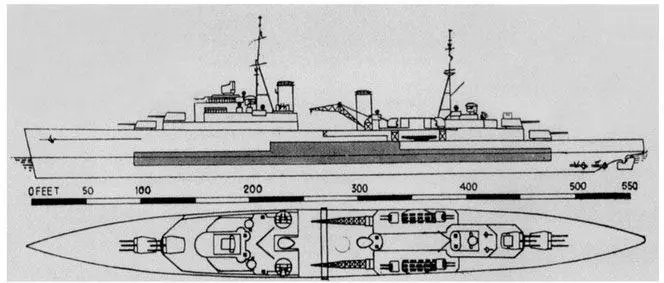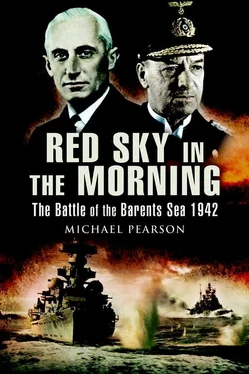However, not all was doom and gloom. Late on 31 December 1942 as U354 reconnoitred the Barents Sea battle area, Admiral Kluber in Narvik took time to send good news to one crew member: ‘To: Herschelb. For Lt. E. Rainer. Its arrived. Going well Dora. Best Wishes.’ [172]
On 24 August 1944 two British corvettes, a frigate, and a destroyer, tracked U354 and sank her with all hands in the Barents Sea. Kapitänleutnant Herschelb, whose message of 31 December 1942 unwittingly helped to cause the seismic upheaval in the German navy following the Battle of the Barents Sea, had previously transferred and was not with the boat at the time.
—♦—
On the outbreak of war with Germany, Soviet industry was capable of manufacturing large quantities of basic but reliable and sturdy weapons of war – guns, tanks, aeroplanes, etc. The problem was the factories, which were almost all situated in western Russia in the immediate path of the invaders. Had these factories been overrun, defeat for the Soviets would have been inevitable, as resupply from Britain and the United States could not hope to keep pace with all the requirements of the Red Army. The solution was both breathtakingly simple and enormously complex. The Russians would move all the plant and machinery, entire factories, eastwards away from the rapidly advancing Germans.
In the four months from July to October 1941, 1½ million trucks and 915,000 railway wagons transported over 1000 factories east, together with the manpower to rebuild them, install plant and machinery, and operate them. Some 100,000 men accompanied the dispersion of Soviet industry eastwards, and the results of this enormous physical and logistical exercise were equally impressive. Aircraft factories moved to Saratov began production before the roofs were on – fourteen days after the last jigs were installed, MiG fighters were rolling off the production line. The tank works transported to Kharkov produced its first twenty-five T-34 tanks ten weeks after engineers rebuilt the factories. Winter in eastern Russia is a desperately hard affair; nevertheless despite atrocious working conditions the winter of 1941/2 saw Soviet arms production reach 4500 tanks, 3000 aircraft, 14,000 guns, and over 50,000 mortars. [173]This equipment would be vital in the coming months, but could not hope to keep pace with the rate of attrition on the Russian front. It was vital that the hundreds of thousands of tons of military hardware and equipment scheduled for transportation from Britain in the Arctic convoys were fought through to Russia.
APPENDIX II
OUTLINE DETAILS OF BRITISH WARSHIPS WITH NOTES ON DEVELOPMENT AND WARTIME CAREERS
Southampton class light cruiser Sheffield
Rear-Admiral Robert Burnett’s Flagship, Force ‘R’
Outline Specification [174]
| Built: |
Vickers Armstrong, Barrow |
| Laid down 1934 |
| Completed 25 August 1937 |
| Dimensions: |
584 ft 0 in (178 m) × 61 ft 8 in (18.8 m) × 17 ft 0 in (5.2 m) |
| Displacement: |
9100 tons (9246 tonnes) |
| Main Armament: |
12 × 6 in (152 mm) in 4 triple turrets, at the time of the Barents Sea action. As the war progressed all the Southampton class had ‘X’ turret removed and replaced by two quadruple Bofors anti-aircraft mountings |
| Anti-aircraft Armament: |
10 × 20 mm fitted 1941, replacing original multiple machine-guns |
| 16 × 2 pdr pompoms |
| Torpedo Tubes: |
6 × 21 in (533 mm) in two triple units |
| Aircraft: |
2 Walrus seaplanes, one housed either side of the fore funnel, in a hangar abaft the bridge |
| 1 catapult athwartships |
| Machinery: |
Parsons geared turbines, built by Vickers |
| Twin-screw. Admiralty 3-drum boilers |
| 75,000 SHP, giving 32 knots |
| Complement: |
833 |

HMS Sheffield (Reproduced with permission from Jane’s Information Group)
Fiji class light cruiser Jamaica
Outline Specification [175]
| Built: |
Vickers Armstrong, Barrow |
| Launched 16 November 1940 |
| Completed 29 June 1942 |
| Dimensions: |
555 ft 6 in (169 m) × 62 ft 0 in (18.9 m) × 16 ft 6 in (5 m) |
| Displacement: |
8000 tons (8128 tonnes) |
| War additions such as torpedoes and extra splinter protection caused the displacement to rise to 8631 tons (8769 tonnes), but without compromising speed |
| Main Armament: |
12 × 6 in (152 mm), in 4 triple turrets |
| Anti-aircraft Armament: |
10 × 20 mm |
| Torpedo Tubes: |
6 × 21 in (533 mm) |
| Aircraft: |
2 box hangars abaft bridge, 1 either side of the fore funnel, equipped to carry Walrus and later Sea Otter seaplanes |
| 1 fixed catapult athwartships |
| Machinery: |
Parsons geared turbines. Quadruple-screw |
| 4 Admiralty 3-drum boilers |
| 72,500 SHP giving 31.5 knots |
| Complement: |
980 |

HMS Jamaica (Reproduced with permission from Jane’s Information Group)
‘O’ class destroyer Onslow
Leader, 17th Destroyer Flotilla, [176]and sister vessels
Obedient , Obdurate , Orwell
| Built: |
Clydebank, 1941 |
| Obedient , Obdurate , Orwell , 1942 |
| Dimensions: |
345 ft 0 in (105 m) × 35 ft 0 in (10.6 m) × 15 ft 8 in (4.67 m) max |
| Displacement: |
1540 tons (1564 tonnes) |
| Main Armament: |
4 × 4.7 in (119 mm) |
| Obedient , Obdurate , Orwell fitted for rapid conversion to minelayers – ‘Y’ gun and both sets of torpedo tubes could be removed and stored ashore, to be replaced by 60 mines in two racks [177] |
| Anti-aircraft Armament: |
4 × 2 pdr |
| 8 × 20 mm |
| Anti-submarine Armament: |
4 mortars [178] |
| Torpedo Tubes: |
8 × 21 in (533 mm) in quadruple mounts |
| Machinery: |
Parsons geared turbines to twin-screws |
| 2 Admiralty 3-drum boilers |
| 40,000 SHP, giving 34 knots |
Acasta class destroyer Achates [179]
| Built: |
Launched Clydebank 4 October 1929 |
| Dimensions: |
323 ft 0 in (98.4 m) × 32 ft 6 in (9.9 m) × 12 ft 0 in (3.65 m) |
| Displacement: |
1330 tons (1351 tonnes) |
| Main Armament: |
Initially 4 × 4.7 in (119 mm) – see anti-submarine equipment below |
| Anti-aircraft Armament: |
Initially 2 × 2 pdr pompoms, 5 machine guns |
| Later replaced by 20 mm a/a guns, and a 12 pdr (see torpedo tubes below) |
| Anti-submarine Armament: |
By 1941 ‘A’ turret replaced by forward throwing Hedgehog a/s mortar, ‘Y’ turret replaced by additional depth charges |
| Torpedo Tubes: |
Initially 8 × 21 in (533 mm), first destroyers to be fitted with quadruple mounts. Aft bank subsequently replaced by 12 pdr a/a gun |
| Machinery: |
Brown-Curtis HP turbines & Parsons LP twinscrew |
| 34,000 SHP, giving 35 knots |
| Complement: |
138 |
Flower class corvettes Rhododendron & Hyderabad [180]
| Built: |
Harland & Wolff, Belfast, 1940 & Alexander Hall, Aberdeen, 1942 |
| Dimensions: |
205 ft 0 in (62.5 m) × 33 ft 0 in (10 m) × 14 ft 6 in (4.42 m) |
| Displacement: |
925 tons (940 tonnes) |
| Guns: |
1 × 4 in (101 mm) |
| Anti-aircraft Armament: |
1 pompom 20 mm machine-guns |
| Anti-submarine Armament: |
1 forward-firing Hedgehog multi-barrelled mortar |
| Machinery: |
Triple expansion |
| 2 SE boilers |
| IHP 2750, giving 16 knots |
| Complement: |
85 |
Halcyon class fleet minesweeper Bramble [181]
| Built: |
Launched Devonport Naval Dockyard 12 July 1938 |
| Dimensions: |
230 ft 0 in (70.1 m) × 33 ft 6 in (10.2 m) × 7 ft 3 in (2.21 m) |
| Displacement: |
875 tons (889 tonnes) |
| Armament: |
2 × 4 in (101 mm) |
| 5 machine-guns |
| Machinery: |
2 × 3-cylinder compound steam engines |
| Twin-screw |
| 2 Admiralty 3-drum boilers |
| 7150 IHP, giving 17 knots |
| Complement: |
80 |
Trawler Northern Gem [182]fitted as rescue ship
| Built: |
Cochrane, 1936 |
| Dimensions: |
173 ft 3 in (52.8 m) × 28 ft 8 in (8.63 m) × 12 ft 6 in (3.81 m) |
| Gross Register Tonnage: |
655 |
| Machinery: |
Triple expansion |
| 1100 IHP, giving 12.5 knots |
Britain’s economy between the wars depended on her vital trade routes with the empire, and her many other overseas trading partners, the Royal Navy’s mainstay for the defence of these trade routes being the cruiser. At the Washington conference of November 1921, pressure was applied to the British delegation, principally by the United States (whose strategic considerations were wholly different from those of Britain), to restrict the number of cruisers in commission. Britain refused but put forward a proposal – which was accepted – that cruisers should not exceed 10,000 tons, and mount guns 8 in (200 mm). The principal concern at this time was not the navy of Germany, but that of Japan, which had undergone major expansion and modernisation and threatened the balance of power in the Pacific.
Читать дальше














